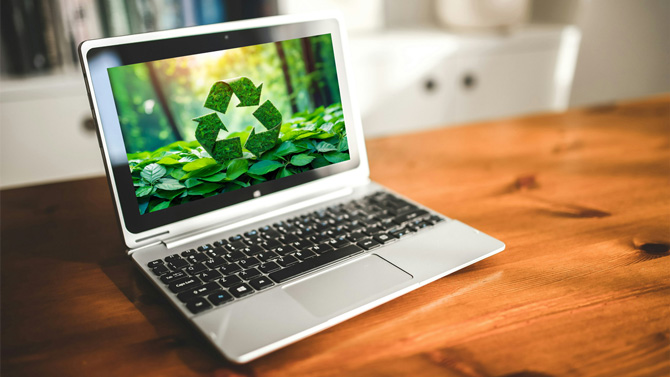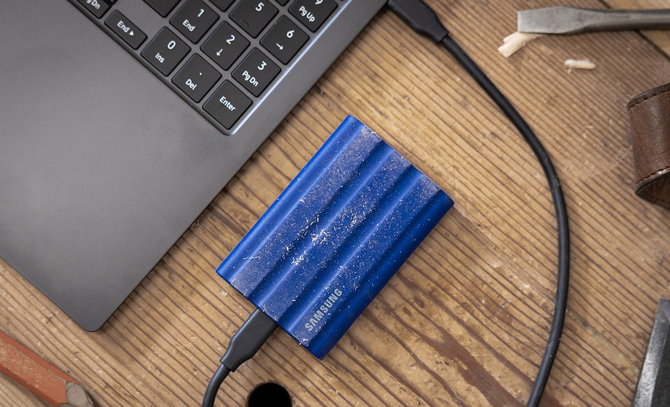Have an old computer lying around the house? Don't just throw it away. Improperly disposing of your old Windows computer can lead to significant environmental and security concerns that can have far-reaching consequences.

Many electronic devices contain toxic materials, such as lead, mercury, and cadmium, which can contaminate soil and water sources if they end up in landfills. And when these devices are incinerated, they release harmful toxins into the air, contributing to air pollution and potential health risks for nearby communities.
From a data privacy perspective, old computers often contain sensitive personal information, such as financial records, passwords, and personal documents. If this data falls into the wrong hands, it can lead to identity theft, financial fraud, and other security breaches. So, taking the necessary steps to protect your personal information and prevent it from being accessed by unauthorized individuals is essential.
Step 1: Secure your data – backing up files
Finding your files
Before you begin the process of getting rid of your old Windows computer, identify and back up all files and documents you want to keep. Take some time to thoroughly review the contents of your computer, including documents, photos, videos, and any other files that hold personal or professional significance. Don't forget to check all folders, including the desktop, downloads, program folders, and any cloud-synced directories. Some programs like to save files with the program data.
Choosing a backup method
Once you have identified the files you need to preserve, you need to choose a suitable backup method. There are a couple of options available, depending on your preferences and the amount of data you need to store. An external SSD drive offers ample storage space and allows you to keep your data physically secure. Alternatively, you can opt for a cloud storage solution, such as Google Drive, Dropbox, or OneDrive, which enable you to access your files from any device with an internet connection.
External SSD Drives
I like the rugged Samsung T7 Shield (starting at $129 for 1TB, on sale starting at $109). It is rugged, has fast read/write speeds, and gets excellent user ratings. Ensure you get a drive with double your computer's capacity for adequate space.

Cloud storage services
Most cloud storage services offer drag-and-drop functionality, making the process straightforward. However, keep in mind that uploading large volumes of data may take some time, depending on your internet connection speed.
When you install Dropbox, backing up your files is as easy as dragging them into the Dropbox folder. Once they're uploaded, you can selectively sync the folders you want to see on your new computer, leaving the rest in the cloud. I've used many file storage services, and I find Dropbox the easiest to use if you have a lot of different file types.
Dropbox offers a stingy 2GB of storage for free, and the next level up is the Plus for $9.99 per month (billed annually). With the Plus plan, you get 2TB of storage, which is in line with other services. There are more expensive plans with 3TB and 5TB of storage that are designed for business use.
Microsoft OneDrive is the best-integrated backup service for Windows PC owners. There's no software installation necessary; you can use the Windows Backup app that comes preloaded on Windows PCs to back up your computer.
OneDrive offers 5GB of storage for free. If you need more space, OneDrive's paid plans include 100GB for $1.99 per month (or $19.99 per year). For larger storage needs, a 1TB option at $6.99 per month (or $69.99 per year) comes with an Office 365 Personal subscription. You also can opt for 6TB of storage at $9.99 per month (or $99.99 per year), which includes Office 365 Home and the ability to share with up to six users.
Google Drive
Google Drive allows you to back up your files by downloading software to your computer and syncing them. It offers 15GB of storage for free. You can upgrade to Google One, Google Drive's premium version for additional space. Google One provides various storage plans: 100GB at $1.99 per month (or $19.99 per year), 200GB at $2.99 per month (or $29.99 per year), and 2TB at $9.99 per month (or $99.99 per year).
Once your backup is complete, it's a good idea to double-check that all essential files have been successfully transferred. Open a few random files from your backup to ensure that they are intact and accessible. This extra step can provide peace of mind and prevent the accidental loss of important data.
2. Deauthorize your computer for software subscriptions
Some programs, such as Microsoft Office 365, only allow you to install software on a limited number of computers or permit a limited number of computers to access your files. So, be sure to deauthorize your old computer with your accounts. You can usually do this online with the service or software provider.
Read More: How to Replace Your Hard Drive with an SSD to Make your Laptop Faster
3. Remove your data
The approach here depends on whether you're recycling or donating your computer.
If you're recycling your computer
If your primary concern is preventing data recovery when recycling your computer, consider physically destroying the hard drive or SSD. This can be done by drilling multiple holes in it (my choice) or smashing it with a hammer. Make sure you use safety glasses!
If you're donating your computer
If you're donating your computer, wiping it clean of all your data is essential; merely deleting files isn't sufficient. Deleted files can remain on your hard drive, invisible but recoverable, making them vulnerable to unauthorized individuals using data recovery programs. Follow the steps below to ensure your data is irretrievably erased and your privacy protected.
Windows 10
- In Windows Settings, go to Update & security > Recovery, and then click the Get Started button.
- When prompted, choose the option to Remove everything.
- Choose the Local reinstall to reinstall Windows from your computer. It's faster than the Cloud download option.
- In the "Additional settings" window, click on Change Settings. Toggle on Clean data. Click Confirm and then click Next. Click Reset to start the process.
Windows 11
- In Windows Settings, go to System > Recovery and then click on Reset PC.
- Select Remove everything when asked about what you want to erase.
- Choose Local reinstall to reinstall Windows. It is faster than the cloud download option.
- From the Additional settings window, click on Change settings, toggle on Clean data, and then click Confirm to start the process.
Note: If you use your computer for business purposes, check with your employer about how to manage business-related information on your computer. The law requires businesses to follow data security and disposal requirements for certain information that's related to customers.
Read More: The Complete Guide to Facebook Privacy Settings
What to do if your computer won't turn on
If your computer won't turn on, the issue is often with the motherboard or power supply. However, your hard drive – and the data stored on it – usually remains intact. To safely back up this data and then erase the drive, follow these steps:
- Remove the hard drive
Carefully take the hard drive out of your non-functional computer. - Connect to another computer
Use a SATA to USB cable (available for under $25 on Amazon) to connect the hard drive to a working computer. This cable converts the hard drive into a USB-compatible device, allowing it to be read by another computer. - Access and back up data
Once connected, your working computer should recognize the hard drive as an external storage device. You can then access and copy your important files to the new computer. - Securely erase the drive
After backing up your data, use a program like Eraser to wipe the hard drive, ensuring all data is permanently deleted. Or, you can damage and stash the drive in a safe place.
Finding a responsible recycler
When disposing of your old electronics, it's important to consider the environmental and social impact. Some recyclers send e-waste to developing countries, where it may end up in piles scavenged by children looking for valuable components. This practice not only harms the environment but also exploits vulnerable populations.
To avoid contributing to this irresponsible practice, use a recycler that has been certified by Sustainable Electronics Recycling International (SERI) as meeting the R2 standard or is part of the "e-Steward" network, meaning they don't export to places like Pakistan or China, and they follow other high standards. Many of them also will reuse and refurbish electronics. Staples is an e-Steward Enterprise that recycles laptops and other consumer electronics for free.
[image credit: Samsung, leaf recycling concept via Adobe Firefly shown in laptop mockup via Canva]
For the past 20+ years, Techlicious founder Suzanne Kantra has been exploring and writing about the world’s most exciting and important science and technology issues. Prior to Techlicious, Suzanne was the Technology Editor for Martha Stewart Living Omnimedia and the Senior Technology Editor for Popular Science. Suzanne has been featured on CNN, CBS, and NBC.













